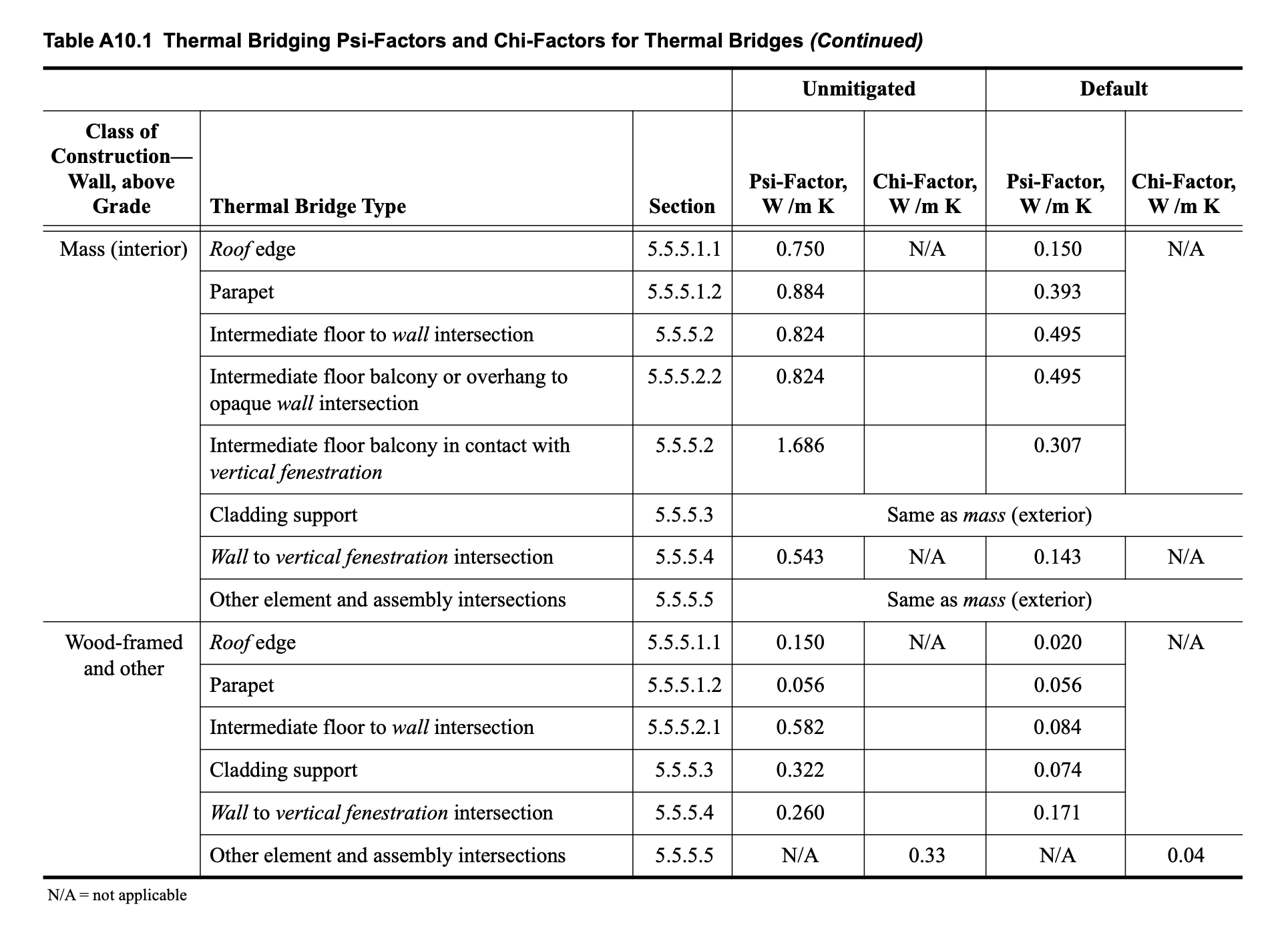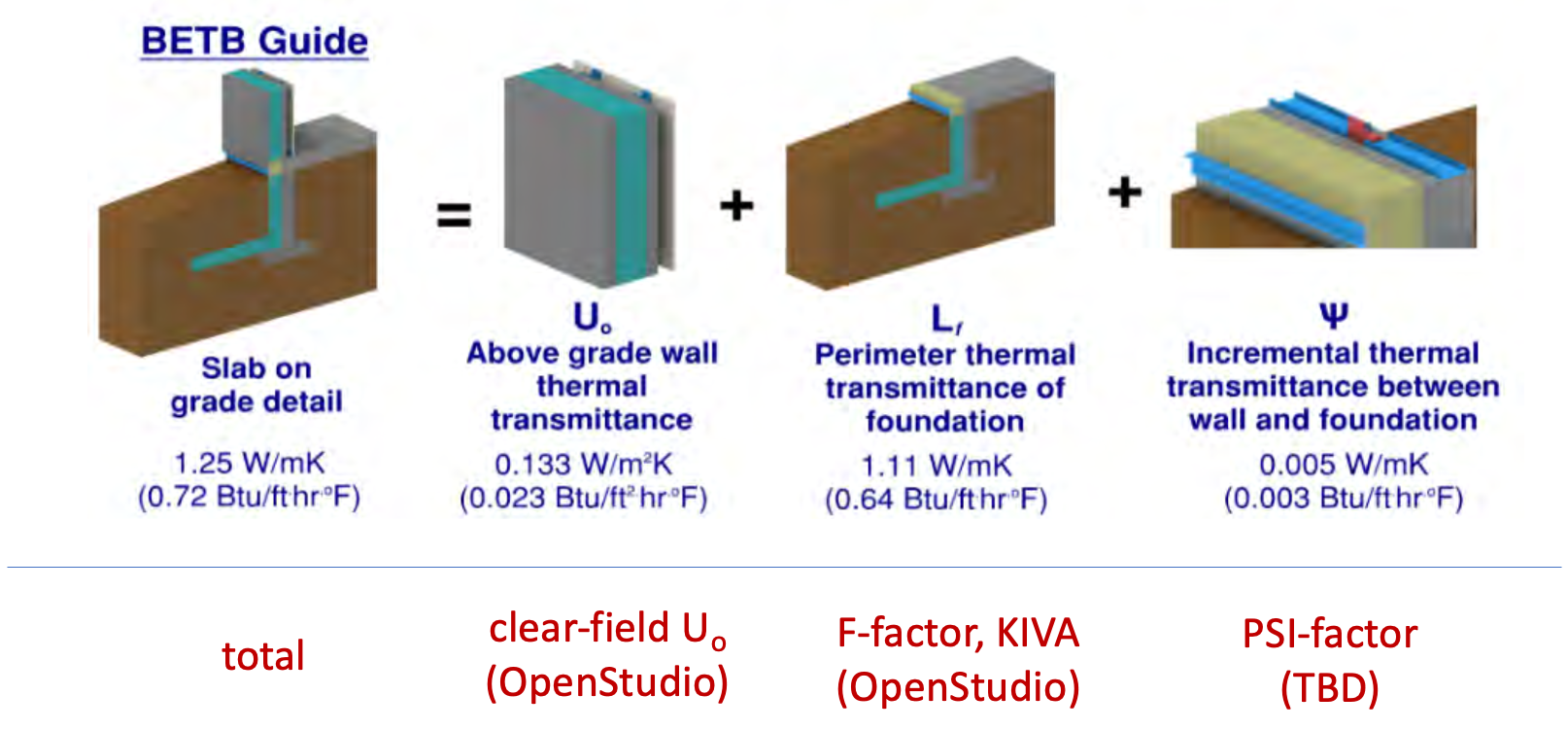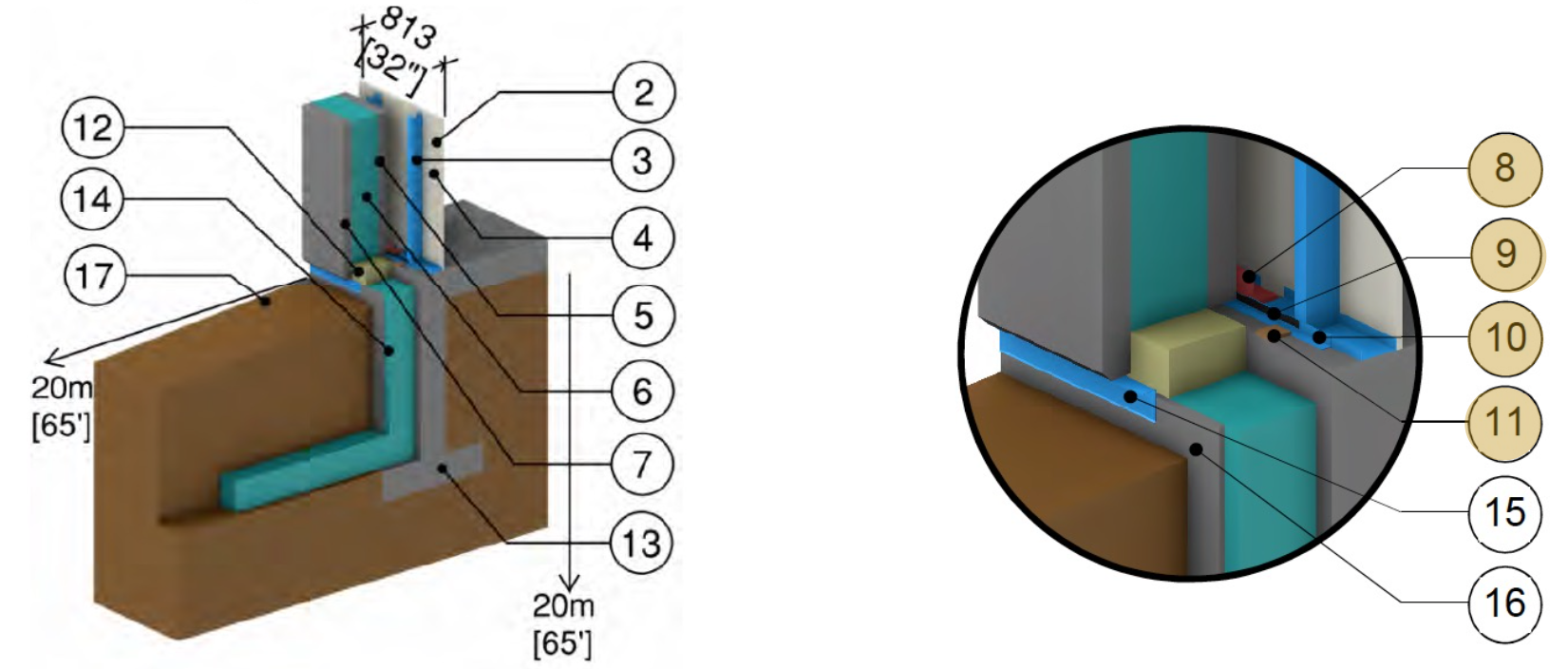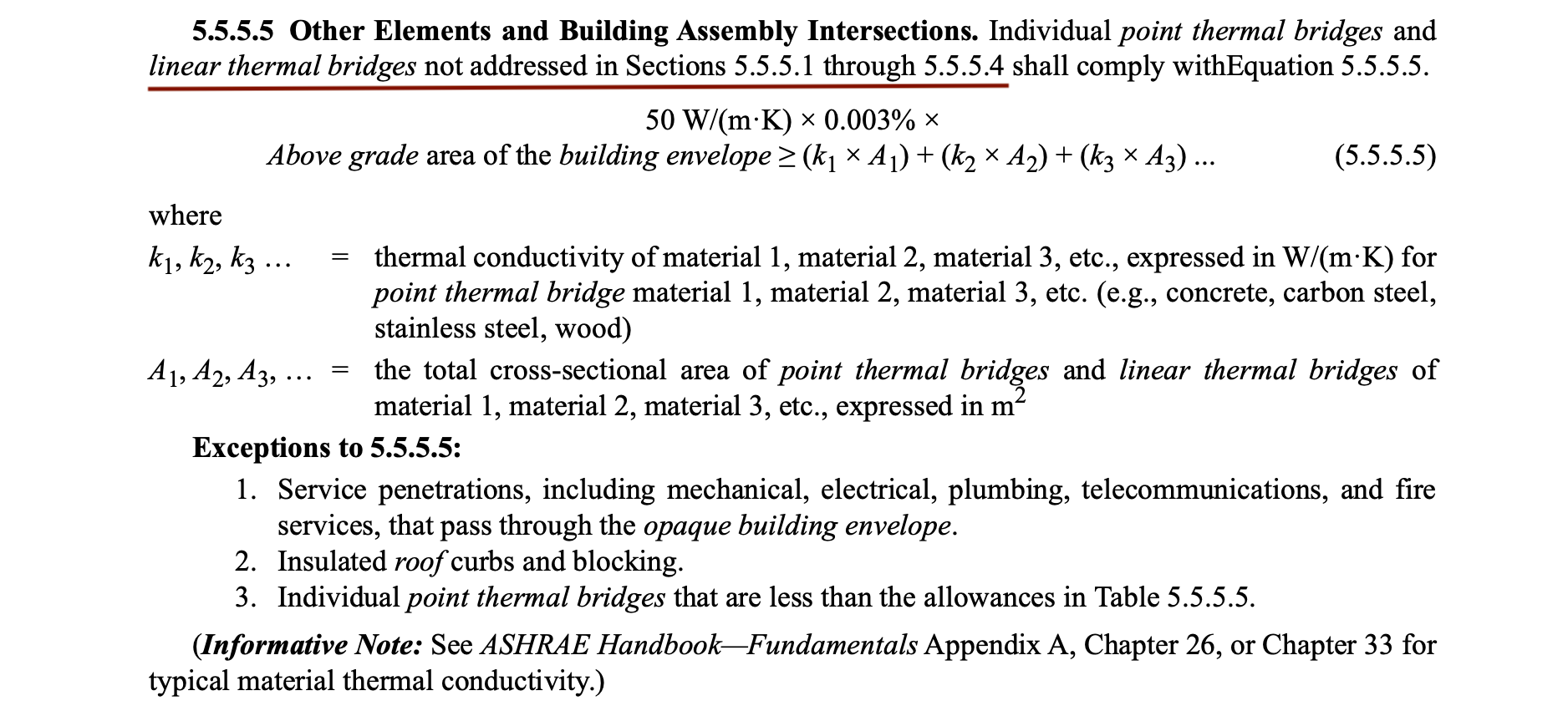Hi everyone. We'll soon release v3.3.0 of the OpenStudio Measure TBD. Code changes include support for ASHRAE 90.1 2022, such as differentiating:
- intermediate floor-to-wall intersections
- attached balcony (often cantilevered) edges
- balcony-to-vertical-fenestration edges (e.g. full height glazing, sliding doors)
Changes made, tests are green. However, we do have interpretation questions concerning 90.1 2022. Feedback/answers to any of these questions are quite welcome, and may drive final adjustments before release. Questions pertain to more than one compliance path, e.g. Energy Cost Budget Method (ECB, Section 12), Performance Rating Method (PRM, Appendix G). To keep things simple, we focus here on linear thermal bridging requirements for ECB (PSI-factors). First, an excerpt of 90.1 2022 (Table A10.1, in SI units):

PSI-factor thresholds differ based on above-grade wall construction (e.g. steel-framed, vs mass, vs wood-framed). Values are provided for both mitigated (default) and unmitigated intersections (or edges), with mitigated values reflecting Section 5 prescriptive requirements (largely descriptive in nature). In a nutshell, ECB requires that listed edges in Table A10.1 be modelled in the Budget Building Design (BBD), if included in the Proposed Design (PD). The BBD shall retain the mitigated PSI-factors in Table A10.1, and have clear-field U-factor adjustments (or be "derated"), as per Section A10.2. Modellers may opt to apply Table A10.1 mitigated or unmitigated PSI-factors for the PD (depending on project details) or instead rely on other sources (such as the BETBG, ISO 14683, test lab results). Development branch v278 (to be released as TBD v3.3.0 once merged):
- includes Table A10.1 PSI-factors and CHI-factors
- identifies/tracks A10.1 listed (and unlisted) edges from OpenStudio model geometry
- automatically derates OpenStudio surface construction clear-field U-factors (per A10.2)
Q1 : TBD identifies/tracks a wider range of linear thermal bridge types than those listed in A10.1. We're unsure if the intention with 90.1 is to exclude these unlisted edges (e.g. corners) altogether, or to process them separately (see Q5 on requirement 5.5.5.5). For the moment, when selecting 90.1 2022 PSI-factor sets, TBD tracks omitted edges (like corners), yet by default applies a PSI-factor of 0 W/K per linear meter. This basically cancels the derating (or bridging) effect of excluded edges, in principle for both BBD and PD models. Are we correct in our interpretation: that 90.1 sets aside such edges? Should we consider unlisted edges as unregulated when applying 90.1, similar to process loads? Answers to Q5 may lead us to a completely different interpretation/solution. Note that with large/simple big box retail or warehouse models, we may encounter half a dozen corner edges (where their combined effect may be quite modest). Yet the impact of corner edges may become significant (!) with highly articulated façade designs (e.g. MURBs with bay windows, niches).
Q2 : In relation to Q1, why such exclusions? Users often need guidance, and knowing why helps. The list of omitted edge types does seem to reflect a lack of published PSI-factors for these details (e.g. very few BETBG corner details). The impression we get is that ASHRAE has chosen to focus on details that are fairly well documented online. One could foresee that Table A10.1 may expand in subsequent editions, based on (future) availability of published PSI-factors. Is our appreciation of the issue sound? Any input from 90.1 TC members would be great!
Q3 : Table A10.1 makes a clear distinction between vertical fenestration, vs all other sub surface types like opaque doors, skylights (90.1 defined terms). Edges around vertical fenestration shall be taken into account, yet are those around opaque doors and skylights also unregulated (like corners)? They're notable thermal bridges, yet are certainly not vertical fenestration. For the moment, TBD follows ASHRAE and makes the distinction between vertical fenestration (which includes glazed doors), vs opaque doors vs skylights. Is our approach correct? And is ASHRAE's position on omitted sub surface perimeters similar to that of corners (based on scarcity of published data)?
Q4 : Slab-on-grade perimeters (or foundation/basement wall edges) are also not listed in Table A10.1. Here, one could argue that the BETBG (better) supports such details, more so than corners for instance. Our understanding is that at-grade edge PSI-factors shouldn't be confused with 90.1 F-factors. The listed PSI-factors would instead describe the bridging effect of e.g. anchors or sill plates on the above-grade wall clear-field U-factor. Sometimes these numbers are very low; sometimes they're quite significant (depending on the wall technology). But it's a bit of a grey area. From the BETBG and the "Guide to Low Thermal Energy Demand for Large Buildings", describing how at-grade PSI-factors are calculated:

… we added the bottom row comments (in red) to help understand what should be modelled how (using OpenStudio as an example):
- clear-field Uo-factor: above-grade, multilayered (opaque) construction - business as usual!
- F-factor, KIVA, etc.: OpenStudio-supported options for below-grade (underground) losses
- at-grade PSI-factor: TBD-tracked linear thermal bridging, derating the clear-field (above-grade) Uo-factor
What is tricky with the BETBG is isolating which components have been associated to PSI-factors. Below is BETBG Detail 7.7.8, where we highlight (in yellow) what components are linked to the published PSI-factor. The other components (not highlighted in yellow) must be factored in either the above-grade clear-field Uo-factor, or the below-grade F-factor … or preferably KIVA (as the resolution/scope of F-factors is fairly narrow).

... 90.1 prescribes F-factors and C-factors for below/at-grade losses, yet it's a bit of a stretch to suggest that published F-factors include thermal bridging of above-grade construction at-grade. This is not obvious for users. Long story short: are at-grade PSI-factors unregulated in 90.1, or are they considered included in F-factors?
Q5 : ECB references linear thermal bridges described in Section 5.5.5, which includes 5.5.5.5 (those not listed in Table A10.1):

This wide-reaching inclusion of "linear thermal briges not addressed in Sections 5.5.5.1 through 5.5.5.4" (i.e. not listed in Table A10.1) sets aside any notion of unregulated linear thermal bridges in 90.1 (suggested in Q1 through Q4). The following edge types (inter alia) would need to be tracked:
- corners
- opaque door perimeters
- skylight perimeters
- expansion joints
- party/demising wall (and/or roof) edges
… TBD indeed tracks such edges. Yet 5.5.5.5 requires that they be characterized via thermal conductivities and areas (not PSI-factors). Ouch! TBD would be of little help here. OpenStudio users would likely need to model additional opaque surfaces (typically as slivers) to account for all unlisted linear thermal bridges. TBD can output all unlisted edges (their lengths, edge types, connected surfaces, etc.), ideally via OpenStudio's Apply Measures Now mode. But it would be up to users (at least in the short/mid term) to parse the TBD JSON output file, then assign widths (thus providing areas) as well as conductivities … not automated, very error-prone, not fun.
We haven't completely wrapped our heads around this yet, but we could foresee adding extra parameters in the TBD JSON input file (e.g. for each unlisted edge type, specify a typical width and associated conductivity). With that, we could automate the rest of the process in TBD. Certainly do-able, yet it would be much easier (!) if 90.1 unlisted details were PSI-factors. Two Q5 questions:
Q5a : It is fairly straightforward to estimate unlisted edge conductivities if the thermal bridge is monolithic (e.g. a cantilevered beam bridging an exterior wall). It becomes nearly impossible (!) for users to estimate averaged conductivities for many unlisted linear thermal bridges, often sophisticated arrangements of conductive structural materials, air gaps, thermal breaks, fasteners, etc. By analogy, just think of the design of a thermally-broken PVC or aluminium window frame. This is why we have standards like NFRC100 (fenestration), and PSI-factors to begin width. Are we missing something? Are there any planned resources (e.g. User Manual) to support 90.1 users (averaged conductivities)?
Q5b : We're having difficulty understanding how to process unlisted linear thermal bridges in the BBD. The reasoning behind Equation 5.5.5.5 isn't obvious to us (yet); what is clear is that it sets a single whole building target. Yet we don't see a similar treatment for the BBD in ECB. Table A10.1 provides a single mitigated CHI factor (e.g. 0.04 for "Wood-frame and other") to apply for "Other element and assembly intersections" (referencing 5.5.5.5). The CHI-factor units should be in W/K (typo?), but that's beside the point. Mitigated CHI-factors, ranging from 0.04 to 0.48 W/K, make sense for individual point conductances (e.g. single cantilevered beam, single ground-floor arcade/loggia column). We're stuck (conceptually) on how to apply a mitigated CHI-factor to unlisted linear thermal bridges (individually or in aggregate). Any insight would be greatly appreciated.
In a nutshell, are unlisted linear thermal bridges unregulated in 90.1? If not, we would need guidance to (better) support 90.1 ECB users when it comes to the BBD.
Q6 : This last one is a side question, related to Q4. We cannot find a sentence in 90.1 allowing recourse to e.g. KIVA as an alternative to F-factors or C-factors. The same could be said for TRNSYS. Are we missing something? Has this motivated (in part) ASHRAE 1857-TRP. Any insight would be appreciated.
We thank you for your interest (and remarkable patience) to go through our questions. Our only goal is to ensure (as much as possible) that TBD supports 90.1 users. We salute ASHRAE for introducing these new requirements in 2022; we hope we can automate as much of the grunt work as possible.
If you want to take a deeper dive on TBD, the online Guide (or this IBPSA-USA overview) may be helpful (although they're now slightly out of date). The PR comments may be more useful when it comes to specific 90.1 adaptations.
Can reach me directly (denis "at" rd2.ca) if you prefer sharing your feedback privately. Merci!




